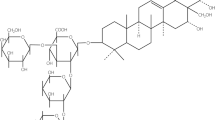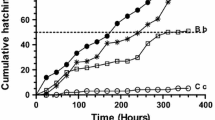Abstract
After screening 200 species of Puerto Rican plants, Solanum nodiflorumwas selected for comprehensive laboratory evaluation as a source of natural molluscicide. All parts of this plant were found toxic to the snails Fossaria (Lymnaea) cubensis, Lymnaea columella, Biomphalaria glabrata,and Physa cubensis.No toxicity was found against Marisa cornuarietisand Tarebia granifera. The toxicant was not affected by pH and dry storage. There was a direct correlation between temperature and molluscicidal activity. The plant is easy to find locally and could be developed into cheap, safe means for controlling both Schistosomaand Fasciolasnail hosts in Puerto Rico.
Similar content being viewed by others
Literature Cited
Bond, H. W. 1973. Arguments in favour of the use of natural products, particularly plant products as molluscicides. 7 pp. Unpubl. ms.
Cardarelli, N. F. 1974. Slow release molluscicides and related material.In Molluscicides in Schistosomiasis Control. T. C. Cheng, ed., pp. 177–240. Academic Press, New York.
Chock, Q. C., C. J. Davis, and M. Chong. 1961.Sepedon macropus (Diptera: Sciomyzidae) introduced into Hawaii as control for the liver fluke snailLymnaea ollula. J. Econ. Entomol. 54: 1–4.
Christie, J. D., M. A. Prentice, E. S. Upatham, and G. Barnish. 1978. Laboratory and field trials of a slow release copper molluscicide in St. Lucia. Amer. J. Trop. Med. Hyg. 27: 616–622.
Duncan, J. 1974. A review of the development and applications of molluscicides in schistosomiasis control.In Molluscicides in Schistosomiasis Control. T. C. Cheng, ed., pp. 9–40. Academic Press, New York.
Ferguson, F. F. 1972. Trends toward biological control of schistosomiasis snails. Proc. Symp. Future Schisto. Control 85-91. New Orleans.
— 1977. The role of biological agents in the control of schistosome bearing snails. U.S. H.E.W. Dept., Center for Disease Control, Bureau of Laboratories. Atlanta, Georgia.
Fox, I., G. A. Rivera, L. S. Ritchie, and L. P. Frick. 1966. Effects of Bayluscide againstAustralorbis glabratus of different ages, strains and cultural conditions. Bull. World Health Organ. 34: 305–306. Harrison, A. D. 1966. The effects of Bayluscide on gastropod snails and other aquatic fauna. Hydrobiologia 28: 371–384.
Jobin, W. R. 1970. Control ofBiomphalaria glabrata in a small reservoir by fluctuation of the water level. Amer. J. Trop. Med. Hyg. 19: 1049–1054.
Lemma, A. 1965. A preliminary report on the molluscicidal properties of endod (Phytolacca dodecandra) Ethiop. Med. J. 3: 187–190.
—. 1970. Laboratory and field evaluation of the molluscicidal properties ofPhytolacca dodecandra. Bull. World Health Organ. 42: 597–612.
Lie, K. J., P. F. Basch, D. Heyneman, A. J. Beck, and R. Audy. 1968. Implications for trematode control of interspecific larvae antagonisms within snail hosts. Roy. Soc. Trop. Med. Hyg. Ord. Meeting 62: 299–319.
Litchfield, J. T., and F. Wilcoxon. 1949. A simplified method of evaluating dose-effect experiments. J. Pharmacol. Exp. Therap. 96: 99–113.
Medina, F. R., and R. Woodbury. 1979. Terrestrial plants molluscicidal to lymnaeid hosts of fascioliasis hepatica in Puerto Rico. J. Agric. Univ. Puerto Rico 63: 366–376.
Radke, M. G., L. S. Ritchie, and F. F. Ferguson. 1961. Demonstrated control ofAustralorbis glabratus byMarisa cornuarietis under field conditions in Puerto Rico. Amer. J. Trop. Med. Hyg. 10: 370–373.
Ritchie, L. S. 1973. Chemical control of snails.In Epidemiology and Control of Schistosomiasis. N. Ansari, ed., pp. 458–532. S. Darger, Basel.
Ruiz-Tiben, E., J. R. Palmer, and F. F. Ferguson. 1969. Biological control ofBiomphalaria glabrata byMarisa cornuarietis in irrigation ponds in Puerto Rico. Bull. World Health Organ. 4: 329- 333.
U.S. Congress. 1976. House of Representatives. Committee on Government Operations. EPA’s implementation of pesticides control act: hearings before a subcommittee on government operations, House of Representatives 94th Congress session. Feb. 11 and March 5, 1976. U.S. Gov. Printing Office, pp. 1–222.
World Health Organization. 1965. Molluscicide screening and evaluation. Bull. World Health Organ. 33: 567–581.
Wright, C. A. 1968. Some views on biological control of trematode diseases. Trans. Roy. Soc. Trop. Med. Hyg. 62: 320–329.
Author information
Authors and Affiliations
Rights and permissions
About this article
Cite this article
Medina, F.R., Ritchie, L.S. Molluscicidal activity of the Puerto Rican Weed,Solatium nodiflorum, against snail hosts ofFasciola hepatica . Econ Bot 34, 368–375 (1980). https://doi.org/10.1007/BF02858313
Received:
Accepted:
Issue Date:
DOI: https://doi.org/10.1007/BF02858313




